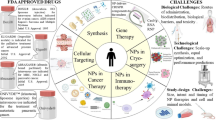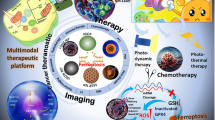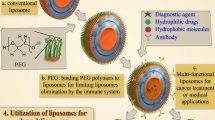Abstract
Active targeting not only of a specific cell but also a specific organelle maximizes the therapeutic activity minimizing adverse side effects in healthy tissues. The present work describes the synthesis, characterization, and in vitro biological activity of active targeting nanoparticles (NP) for cancer therapy based on α-tocopheryl succinate (α-TOS), a well-known mitocan, that selectively induces apoptosis of cancer cells and proliferalting endothelial cells. Human epidermal growth factor receptor 2 (HER2) targeting peptide LTVSPWY (PEP) and triphenylphosphonium lipophilic cation (TPP) were conjugated to a previously optimized RAFT block copolymer that formed self-assembled NP of appropriate size for this application and low polydispersity by self-organized precipitation method. PEP and TPP were included in order to target not only HER2 positive cancer cells, but also the mitochondria of these cancer cells, respectively. The in vitro experiments demonstrated the faster incorporation of the active-targeting NP and the higher accumulation of TPP-bearing NP in the mitochondria of MDA-MB-453 HER2 positive cancer cells compared to non-decorated NP. Moreover, the encapsulation of additional α-TOS in the hydrophobic core of the NP was achieved with high efficiencies. The loaded NP presented higher cytotoxicity than unloaded NP but preserved their selectivity against cancer cells in a range of tested concentrations.
Graphical abstract






Similar content being viewed by others
Change history
12 October 2017
A correction to this article has been published.
References
Biswas S, Torchilin VP. Nanopreparations for organelle-specific delivery in cancer. Adv Drug Deliv Rev. 2014;66:26–41.
Pathania D, Millard M, Neamati N. Opportunities in discovery and delivery of anticancer drugs targeting mitochondria and cancer cell metabolism. Adv Drug Deliv Rev. 2009;61(14):1250–75.
Wallace DC. A mitochondrial paradigm of metabolic and degenerative diseases, aging, and cancer: a dawn for evolutionary medicine. Annu Rev Genet. 2005;39:359–407.
Neuzil J, Pervaiz S, Fulda S. Mitochondria: the Anti-cancer Target for the Third Millennium. Dordrecht: Springer; 2014.
Fulda S. Exploiting mitochondrial apoptosis for the treatment of cancer. Mitochondrion. 2010;10(6):598–603.
Ngo H, Tortorella SM, Ververis K, Karagiannis TC. The Warburg effect: molecular aspects and therapeutic possibilities. Mol Biol Rep. 2015;42(4):825–34.
Modica-Napolitano JS, Singh KK. Mitochondrial dysfunction in cancer. Mitochondrion. 2004;4(5):755–62.
Owens KM, Modica-Napolitano J, Singh KK. Mitochondria and cancer. Mitochondria and Cancer. New York: Springer; 2009. p. 1-21.
Wen S, Zhu D, Huang P. Targeting cancer cell mitochondria as a therapeutic approach. Future Med Chem. 2013;5(1):53–67.
Biasutto L, Dong L-F, Zoratti M, Neuzil J. Mitochondrially targeted anti-cancer agents. Mitochondrion. 2010;10(6):670–81.
Dong L-F, Neuzil J. Mitochondria in cancer: why mitochondria are a good target for cancer therapy. Prog Mol Biol Translational Sci. 2014;127:211.
Neuzil J, Dong L-F, Rohlena J, Truksa J, Ralph SJ. Classification of mitocans, anti-cancer drugs acting on mitochondria. Mitochondrion. 2013;13(3):199–208.
Neuzil J, Tomasetti M, Zhao Y, Dong L-F, Birringer M, Wang X-F, et al. Vitamin E analogs, a novel group of “mitocans,” as anticancer agents: the importance of being redox-silent. Mol Pharmacol. 2007;71(5):1185–99.
Dong Y, Guo Y, Gu X. Anticancer mechanisms of vitamin E succinate. Chin J Cancer. 2009;28(10):1114–8.
Rohlena J, Dong LF, Kluckova K, Zobalova R, Goodwin J, Tilly D, et al. Mitochondrially targeted α-tocopheryl succinate is antiangiogenic: potential benefit against tumor angiogenesis but caution against wound healing. Antioxid Redox Signal. 2011;15(12):2923–35. https://doi.org/10.1089/ars.2011.4192.
Dong L-F, Low P, Dyason JC, Wang X-F, Prochazka L, Witting PK, et al. α-Tocopheryl succinate induces apoptosis by targeting ubiquinone-binding sites in mitochondrial respiratory complex II. Oncogene. 2008;27(31):4324–35.
Dong L-F, Freeman R, Liu J, Zobalova R, Marin-Hernandez A, Stantic M, et al. Suppression of tumor growth in vivo by the mitocan α-tocopheryl succinate requires respiratory complex II. Clin Cancer Res. 2009;15(5):1593–600.
Neuzil J, Dyason JC, Freeman R, Dong L-F, Prochazka L, Wang X-F, et al. Mitocans as anti-cancer agents targeting mitochondria: lessons from studies with vitamin E analogues, inhibitors of complex II. J Bioenerg Biomembr. 2007;39(1):65–72.
Dong L-F, Neuzil J. Vitamin E analogues as prototypic mitochondria-targeting anti-cancer agents. mitochondria: the anti-cancer target for the third millennium. Dordrecht: Springer; 2014. p. 151-81.
Neuzil J, Weber T, Gellert N, Weber C. Selective cancer cell killing by α-tocopheryl succinate. Br J Cancer. 2001;84(1):87.
Dong L-F, Swettenham E, Eliasson J, Wang X-F, Gold M, Medunic Y, et al. Vitamin E analogues inhibit angiogenesis by selective induction of apoptosis in proliferating endothelial cells: the role of oxidative stress. Cancer Res. 2007;67(24):11906–13.
Duhem N, Danhier F, Préat V. Vitamin E-based nanomedicines for anti-cancer drug delivery. J Controlled Release. 2014;182:33–44.
Koudelka S, Knotigova PT, Masek J, Prochazka L, Lukac R, Miller AD, et al. Liposomal delivery systems for anti-cancer analogues of vitamin E. J Controlled Release. 2015;207:59–69.
Palao-Suay R, Aguilar MR, Parra-Ruiz FJ, Fernández-Gutiérrez M, Parra J, Sánchez-Rodríguez C, et al. Anticancer and antiangiogenic activity of surfactant-free nanoparticles based on self-assembled polymeric derivatives of vitamin E: structure-activity relationship. Biomacromolecules. 2015;16(5):1566–81. https://doi.org/10.1021/acs.biomac.5b00130.
Palao‐Suay R, Rodrigáñez L, Aguilar MR, Sánchez‐Rodríguez C, Parra F, Fernández M, et al. Mitochondrially targeted nanoparticles based on α‐TOS for the selective cancer treatment. Macromol Biosci. 2016;16(3):395–411.
Palao-Suay R, Aguilar MR, Parra-Ruiz FJ, Maji S, Hoogenboom R, Rohner N, et al. α-TOS-based RAFT block copolymers and their NPs for the treatment of cancer. Polymer Chem. 2016;7(4):838–50.
Palao-Suay R, Aguilar MR, Parra-Ruiz FJ, Maji S, Hoogenboom R, Rohner NA, et al. Enhanced bioactivity of α-Tocopheryl succinate based block copolymer nanoparticles by reduced hydrophobicity. Macromol Biosci. 2016;16(12):1824–37.
Dong L-F, Jameson VJ, Tilly D, Cerny J, Mahdavian E, Marín-Hernández A, et al. Mitochondrial targeting of vitamin E succinate enhances its pro-apoptotic and anti-cancer activity via mitochondrial complex II. J Biol Chem. 2011;286(5):3717–28.
Rin Jean S, Tulumello DV, Wisnovsky SP, Lei EK, Pereira MP, Kelley SO. Molecular vehicles for mitochondrial chemical biology and drug delivery. ACS Chem Biol. 2014;9(2):323–33.
Modica-Napolitano JS, Weissig V. Treatment strategies that enhance the efficacy and selectivity of mitochondria-targeted anticancer agents. Int J Mol Sci. 2015;16(8):17394–421.
Murphy MP. Targeting lipophilic cations to mitochondria. Biochim Biophys Acta (BBA)-Bioenergetics. 2008;1777(7):1028–31.
Smith RA, Porteous CM, Gane AM, Murphy MP. Delivery of bioactive molecules to mitochondria in vivo. Proc Natl Academy Sci. 2003;100(9):5407–12.
Dong L-F, Jameson VJ, Tilly D, Prochazka L, Rohlena J, Valis K, et al. Mitochondrial targeting of α-tocopheryl succinate enhances its pro-apoptotic efficacy: a new paradigm for effective cancer therapy. Free Radical Biol Med. 2011;50(11):1546–55.
Han M, Vakili MR, Soleymani Abyaneh H, Molavi O, Lai R, Lavasanifar A. Mitochondrial delivery of doxorubicin via triphenylphosphine modification for overcoming drug resistance in MDA-MB-435/DOX cells. Mol Pharm. 2014;11(8):2640–9.
Biswas S, Dodwadkar NS, Deshpande PP, Torchilin VP. Liposomes loaded with paclitaxel and modified with novel triphenylphosphonium-PEG-PE conjugate possess low toxicity, target mitochondria and demonstrate enhanced antitumor effects in vitro and in vivo. J Controlled Release. 2012;159(3):393–402.
Zhou J, Zhao W-Y, Ma X, Ju R-J, Li X-Y, Li N, et al. The anticancer efficacy of paclitaxel liposomes modified with mitochondrial targeting conjugate in resistant lung cancer. Biomaterials. 2013;34(14):3626–38.
Marrache S, Dhar S. Engineering of blended nanoparticle platform for delivery of mitochondria-acting therapeutics. Proc Natl Academy Sci. 2012;109(40):16288–93.
Sharma A, Soliman GM, Al-Hajaj N, Sharma R, Maysinger D, Kakkar A. Design and evaluation of multifunctional nanocarriers for selective delivery of coenzyme Q10 to mitochondria. Biomacromolecules. 2011;13(1):239–52.
Wongrakpanich A, Geary SM, Joiner M-lA, Anderson ME, Salem AK. Mitochondria-targeting particles. Nanomedicine. 2014;9(16):2531–43.
Durazo SA, Kompella UB. Functionalized nanosystems for targeted mitochondrial delivery. Mitochondrion. 2012;12(2):190–201.
Wang X-F, Birringer M, Dong L-F, Veprek P, Low P, Swettenham E, et al. A peptide conjugate of vitamin E succinate targets breast cancer cells with high ErbB2 expression. Cancer Res. 2007;67(7):3337–44.
Byrne JD, Betancourt T, Brannon-Peppas L. Active targeting schemes for nanoparticle systems in cancer therapeutics. Adv Drug Deliv Rev. 2008;60(15):1615–26.
Ferlay J, Shin H, Bray F, Forman D, Mathers C, Parkin D. Cancer Incidence and Mortality Worldwide. Int Agency Res Cancer. 2012.
Tai W, Mahato R, Cheng K. The role of HER2 in cancer therapy and targeted drug delivery. J Controlled Release. 2010;146(3):264–75.
Hurvitz SA, Hu Y, O’Brien N, Finn RS. Current approaches and future directions in the treatment of HER2-positive breast cancer. Cancer Treat Rev. 2013;39(3):219–29.
Nahta R, Yu D, Hung M-C, Hortobagyi GN, Esteva FJ. Mechanisms of disease: understanding resistance to HER2-targeted therapy in human breast cancer. Nat Clin Pract Oncol. 2006;3(5):269–80.
Ruoslahti E. Peptides as targeting elements and tissue penetration devices for nanoparticles. Adv Mater. 2012;24(28):3747–56.
Krag DN, Shukla GS, Shen G-P, Pero S, Ashikaga T, Fuller S, et al. Selection of tumor-binding ligands in cancer patients with phage display libraries. Cancer Res. 2006;66(15):7724–33.
Shadidi M, Sioud M. Identification of novel carrier peptides for the specific delivery of therapeutics into cancer cells. FASEB J. 2003;17(2):256–8.
Orbán E, Manea M, Marquadt A, Bánóczi Z, Csı́k G, Fellinger E, et al. A new daunomycin–peptide conjugate: synthesis, characterization and the effect on the protein expression profile of HL-60 cells in vitro. Bioconjug Chem. 2011;22(10):2154–65.
Palao-Suay R, Martín-Saavedra FM, Rosa Aguilar M, Escudero-Duch C, Martín-Saldaña S, Parra-Ruiz FJ, et al. Photothermal and photodynamic activity of polymeric nanoparticles based on α-tocopheryl succinate-RAFT block copolymers conjugated to IR-780. Acta Biomater. 2017. https://doi.org/10.1016/j.actbio.2017.05.028.
Yabu H. Creation of functional and structured polymer particles by self-organized precipitation (SORP). Bull Chem Soc Jpn. 2012;85(3):265–74.
Page B, Page M, Noel C. A new fluorometric assay for cytotoxicity measurements in vitro. Int J Oncol. 1993;3(3):473–6.
Hatakeyama H, Akita H, Harashima H. The polyethyleneglycol dilemma: advantage and disadvantage of PEGylation of liposomes for systemic genes and nucleic acids delivery to tumors. Biol Pharm Bull. 2013;36(6):892–9.
Branco MC, Schneider JP. Self-assembling materials for therapeutic delivery. Acta Biomater. 2009;5(3):817–31.
Lu Y, Park K. Polymeric micelles and alternative nanonized delivery vehicles for poorly soluble drugs. Int J Pharm. 2013;453(1):198–214.
Feng S-S, Mei L, Anitha P, Gan CW, Zhou W. Poly (lactide)–vitamin E derivative/montmorillonite nanoparticle formulations for the oral delivery of Docetaxel. Biomaterials. 2009;30(19):3297–306.
Pan J, Feng S-S. Targeted delivery of paclitaxel using folate-decorated poly (lactide)–vitamin E TPGS nanoparticles. Biomaterials. 2008;29(17):2663–72.
Mei L, Zhang Y, Zheng Y, Tian G, Song C, Yang D, et al. A novel docetaxel-loaded poly (ε-caprolactone)/pluronic F68 nanoparticle overcoming multidrug resistance for breast cancer treatment. Nanoscale Res Lett. 2009;4(12):1530–9.
Holliday DL, Speirs V. Choosing the right cell line for breast cancer research. Breast Cancer Res. 2011;13(4):215.
Toss A, Cristofanilli M. Molecular characterization and targeted therapeutic approaches in breast cancer. Breast Cancer Res. 2015;17(1):60.
Yameen B, Choi WI, Vilos C, Swami A, Shi J, Farokhzad OC. Insight into nanoparticle cellular uptake and intracellular targeting. J Controlled Release. 2014;190:485–99.
McMahon HT, Boucrot E. Molecular mechanism and physiological functions of clathrin-mediated endocytosis. Nat Rev Mol Cell Biol. 2011;12(8):517–33.
Xu S, Olenyuk BZ, Okamoto CT, Hamm-Alvarez SF. Targeting receptor-mediated endocytotic pathways with nanoparticles: rationale and advances. Adv Drug Deliv Rev. 2013;65(1):121–38.
Acknowledgements
Authors acknowledge, David Gómez, and Rosa Ana Ramírez and Mar Fernández for their help in SEM, and cell culture experiments, respectively.
Funding sources
This work was funded by the Spanish Ministry of Economy and Competitiveness (MAT2014-51918-C2-1-R) and CIBER BBN-ECO Foundation project, CSIC (201660I028) and the National Institutes of Health Cell and Tissue Engineering Training Grant T32 GM008433.
Author contributions
The manuscript was written through contributions of all authors. All authors have given approval to the final version of the manuscript.
Author information
Authors and Affiliations
Corresponding author
Ethics declarations
Conflict of interest
The authors declare that they have no competing interests.
Additional information
The original version of this article was revised: The original version of this article unfortunately contained mistakes. The “Reflections on Career Goals” and the group photo were missing in the original version of this article. They are given below. The original article was corrected.
A correction to this article is available online at https://doi.org/10.1007/s10856-017-5995-3.
Electronic supplementary material
Rights and permissions
About this article
Cite this article
Palao-Suay, R., Aguilar, M.R., Parra-Ruiz, F.J. et al. Multifunctional decoration of alpha-tocopheryl succinate-based NP for cancer treatment: effect of TPP and LTVSPWY peptide. J Mater Sci: Mater Med 28, 152 (2017). https://doi.org/10.1007/s10856-017-5963-y
Received:
Accepted:
Published:
DOI: https://doi.org/10.1007/s10856-017-5963-y




